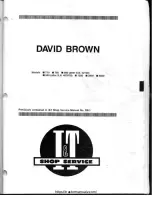
OPERATIONAL CONTROLS
Operation - 26
Hazard Flasher Switch (CC)
0. Hazard Flasher Off
1. Hazard Flasher On
0
1
Pressing the right portion of the hazard flasher
switch flashes both directional turn signal lights.
Pressing the left portion of the switch turns the
hazard flasher lights off. Use of the directional turn
signals will override the hazard flashers until the
turn signals are turned off.
Work Light Switch (DD)
Depressing the front (1) of the
0
1
0. Off
1. On
work light switch turns the work
lights on. Pressing the back (0) of the switch
turns the work lights off.
Strobe Light Switch (EE)
Pressing the front (1) of the
0
1
0. Off
1. On
strobe light switch turns the strobe
light on. Pressing the back (0) of the switch
turns the strobe light off.
12 Volt Rear Switches & 4-Pin Socket
(FF, GG, & HH)
The rear 4-pin socket
0. Off
1. On
0
1
2
3
2. Momentary On
3. Momentary On
provides electrical power
to rear mounted attach-
ments that are equipped
with electrical controls.
(e.g. ES220 Spreader)
The switches turn on and
off the electrical power to
the rear 4-pin socket.
Pressing the left portion
(1) of the on/off switch
turns electrical power
to the 4-pin socket on.
Pressing the right portion
(0) of the switch turns
electrical power off.
Pressing the left (2) or
right (3) portion of the momentary on/off/momentary
on switch turns electrical power to the 4-pin socket
on. Releasing the switch turns electrical power off.
12 Volt Front Switches & 4-Pin Socket
(RR, SS, & TT)
The front 4-pin socket
1
0
2
3
0. Off
1. On
2. Momentary On
3. Momentary On
provides electrical
power to attachments
that are equipped with
electrical controls.
(e.g. broom rotation
actuator)
The switches turn on
and off the electrical
power to the front 4-pin socket.
Pressing the top portion (1) of the
on/off switch turns electrical power
to the 4-pin socket on. Pressing
the bottom portion (2) of the switch turns electrical
power off.
Pressing either the top (3) or bottom (4) momentary
on switch turns electrical power to the 4-pin socket on.
Releasing the switch turns electrical power off.
Front Hitch Valve (MM)
The front hitch valve
1. Slow/Locked
2. Fast
1
2
is used to control the
lowering of the front
hitch.
Turning the knob on
the front hitch valve
counterclockwise
increases the speed at which the front
hitch and attachment can be lowered.
Turning the knob clockwise decreases the speed at
which the front hitch and attachment can be lowered.
The front hitch and attachment can be locked in any
position so that it will not lower, by turning the front
hitch valve knob clockwise until it is completely closed.













































